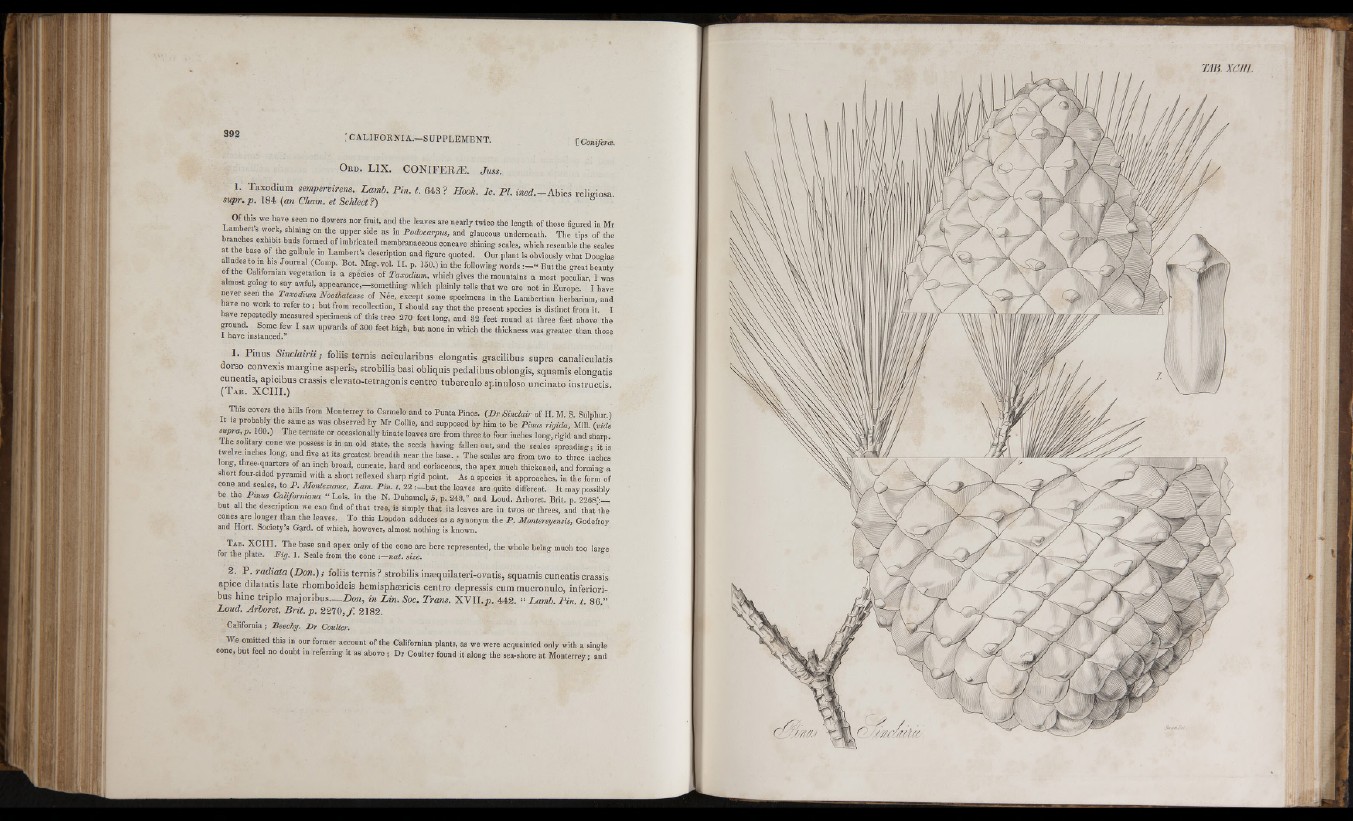
I«« * to)
?■ ' f'i
O b d . LIX . CO N IFERÆ . Juss.
1. Taxodium sempervlrem. L am h . Pin. t. 6 4 3 ? Hooh. Ic . PI. ¿ « « /.-A b ie s religiosa.
supr. p . 184 (an Cham, et Schlect?)
Of this we hate seen no flowers nor fruit, and the leaves are nearly twice the length of those figured in Mr
Lamberts work, shining on the upper side as in Podocarpus, and glaucous undornealli. The tips of the
branches exhibit buds formed of imbricated membranaceous concave shining scales, which resemble tho seaies
a the base of the galbnle in Lambert’s description and figure quoted. Our plant is obviously what Douglas
alludes to in his Journal (Comp. Bot, Mag. vol. I I . p. 150.)in the following words i - « But tbe great beauty
ot the Lalifomian vegetation is a species of Taxodium, which gives the mountains a most peculiar I was
almost going to say awful, appearance.-something which plainly lolls that we are not in Europe. I have
never seen the Taxodmm Noothatmsc of Née, except some specimens in the Lambertian herbarium, and
have no work to refer to ; bnt from reeolleclion, I should say that the present species is distinct from it. I
have repeatedly measured speeimens of this tree 270 feet long, and 32 feet round at three feet above the
gronnd.^ Some few I saw upwards of 300 feet high, bnt none in which the thickness was greater than those
i nave instanced.” °
1. Em us S in c la irii; foliis ternis acicularibus eiongatis gracilibus su p ra canaliculatis
dorso convexis margine asperis, strobilis basi obliquis pedalibus oblongis, squamis elonoatis
cuneatis, apicibus crassis elevato-tetragonis c entro tubérculo spinuloso uncinato instructis.
( T a b . X C III.)
This covers the hills from Monteney to Carmelo and to Punta Pinos. (Dr Sinclair of H. M. S. Sulphur )
It IS probably the same as was observed by Mr Collie, and supposed by him to be Pinus rigida, Mill, {vide
svpra,p. 160.) The ternate or occasionally binate leaves are from three to four inches long, rigid and sharp.
The solitary cone we possess is in an old state, the seeds having fallen out, and the scales spreading; it is
twelve inches long, and five at its greatest breadth near the base. . The scales are from two to three inches
long, three-quarters of an inch broad, cuneate, hard and coriaceous, the apex much thickened, and formin<r a
short four-sided pyramid with a short reflexed sharp rigid point. As a species it approaches, in the form of
cone and scales, to P. Moniezumce, Lam. Pin. t. 22 :_ b u t the leaves are quite different. It may possibly
be the Pinus Californiana “ Lois, in the N. Duhamel, 5, p. 243.” and Loud. Arboret. Brit. p. 2268':—
but all the description we can find of that tree, is simply that its leaves are in twos or threes, and that*fhe
cones are longer than the leaves. To this Loudon adduces as a synonym the P. Montereyensis, Godefroy
and Hort. Society’s Gard. of which, however, almost nothing is known.
T a b . XCIII. The base and apex only of the cone ate here represented, the whole being much too large
for the plate. Fig. I. Scale from the cone -.—nat. size.
2. P . radiaia {Don.); folüs tern is? strobilis inæquilateri-ovatis, squamis cuneatis crassis
apice dilatatis late rhomboideis hemisphæricis centro depressis cum m ucronulo, inferioribus
hinc trip lo majoribus.—Do», in L in . Soc. Trans. X W U .p . 442. Lamb. Pin . t. 86.”
L oud. Arboret. B r it. p . 2 2 7 0 , / 2182.
California ; Beechy. Dr Coulter.
We omitted this in our former account of the Californian plants, as we were acquainted only with a single
cone, but feel no doubt in referring it as above ; Dr Coulter found it along the sea-shore at Monterrey ; and
m i x c jH .
til
■ hf
t i l :
I t i :
i
fi,